The Institution of the Society of the Cincinnati, adopted on May 13, 1783, directs that delegates to the General Society will meet the “on the first Monday in May, annually, so long as they shall be necessary, and afterwards, at least once in every three years.” The first general meeting convened in Philadelphia on May 4, 1784, and lasted two full weeks. Since then, with just a few gaps in the early nineteenth century, delegates from the constituent societies have gathered as a body at least every three years as mandated by the Institution.
The Triennial Meetings are an essential aspect of the governance of the Society, at which general officers are elected and resolutions affecting the Society’s operations and membership are debated and adopted. Until the mid-twentieth century, the Triennials were the chief business meetings of the Society. In modern times, with the Board of Directors and Standing Committee meeting more frequently, these gatherings mark the transition from one administration to another. But the most enduring tradition of the Triennials is the fellowship the meetings foster among the members, inspired by the example of General Washington and his officers.
With portraits, letters, photographs, and other artifacts drawn exclusively from the Society of the Cincinnati’s museum and library collections, the exhibition Once in Every Three Years chronicled the Society’s aspirations, setbacks, and successes over more than two centuries, as reflected in its Triennial Meetings. From a challenge to the Society’s basic foundation made by the first president general, George Washington, through decades of dwindling membership and the threats of the sectional divisions of the Civil War, and finally to a full and complete revival, there has been a remarkable continuity of purpose as each generation has carried forward the original mission of the founders—to perpetuate the memory of the achievement of American independence.
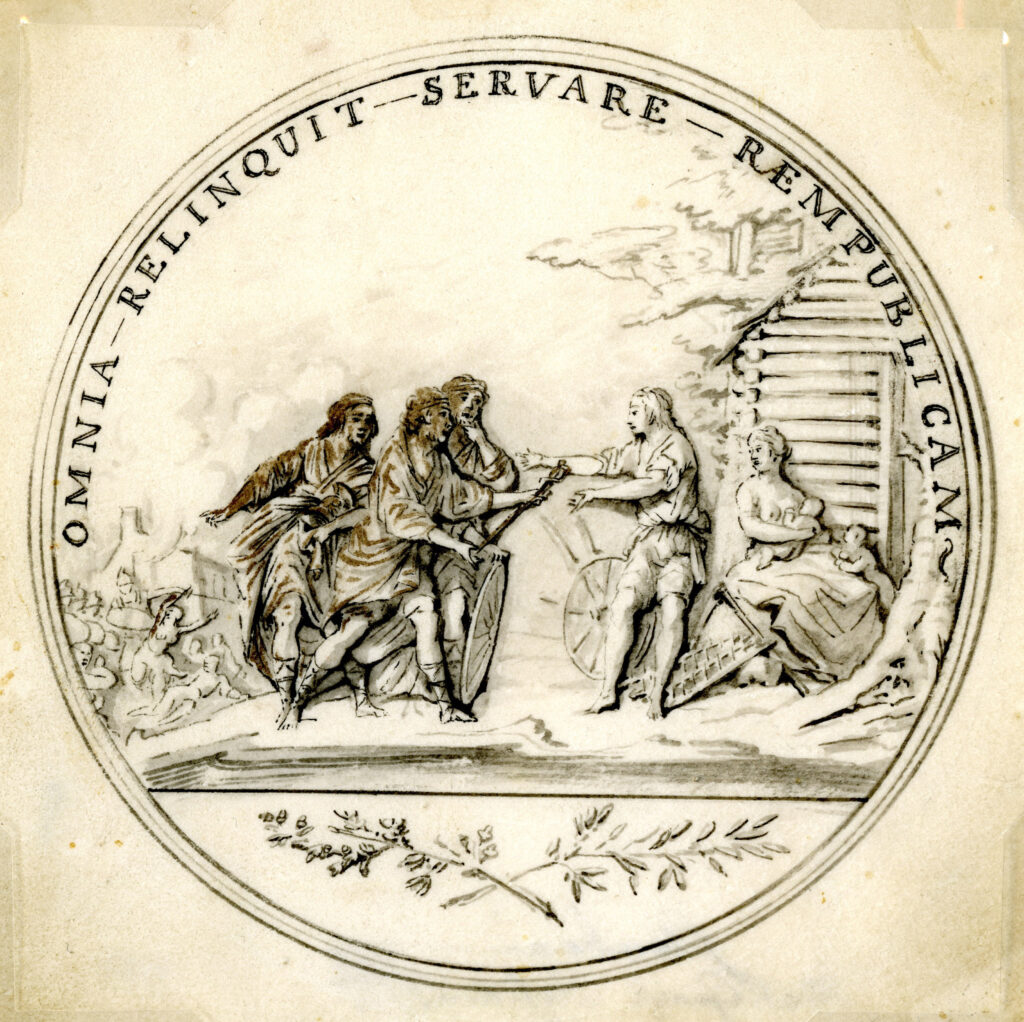
Pierre-Charles L’Enfant (1754-1825)
1783
The Society of the Cincinnati Archives
At the request of the Society, Pierre-Charles L’Enfant, a major in the Continental Army Corps of Engineers, drew an ink-and-wash design for a medal bearing imagery of the life of Cincinnatus as described in the Institution. But he also took the liberty of submitting with it an alternative proposal for a badge in the form of an American bald eagle. In June 1783, the Society adopted the Eagle as its insignia and placed the sketch for the medal in its archives. It was not until 1914 that the Maryland Society of the Cincinnati used L’Enfant’s design as the basis for a medal struck to present to the attendees of the Baltimore Triennial that year.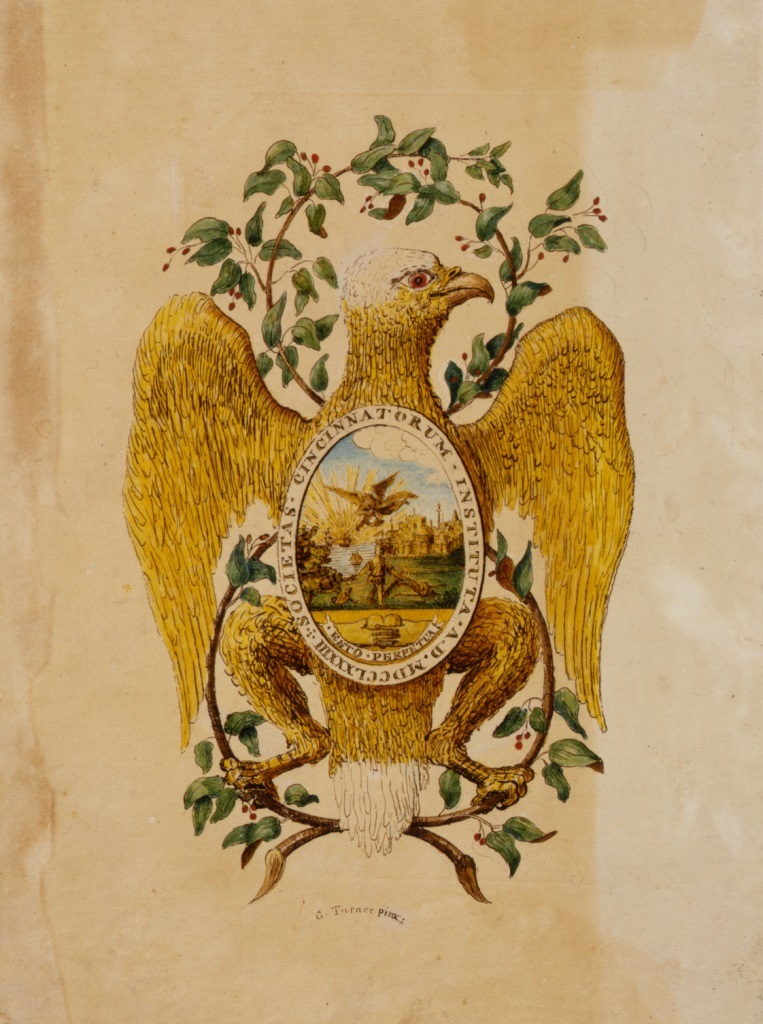
Kept by George Turner
1784-1787
The Society of the Cincinnati Archives
The first general meeting held in Philadelphia in May 1784 brought a change to the basic foundation of the Society that would not be resolved for sixteen years. Concerned over widely circulating criticism that the Society would create “a race of hereditary patricians” antithetical to the ideas of the new republic, President General George Washington proposed amendments to the year-old Institution that would abolish the hereditary provision and essentially devolve all power and decision making to the constituent branches. This minute book of proceedings of the Society’s earliest meetings kept by Assistant Secretary General George Turner bears his elaborate watercolor rendering of the Society’s Eagle on its front paste-down end paper.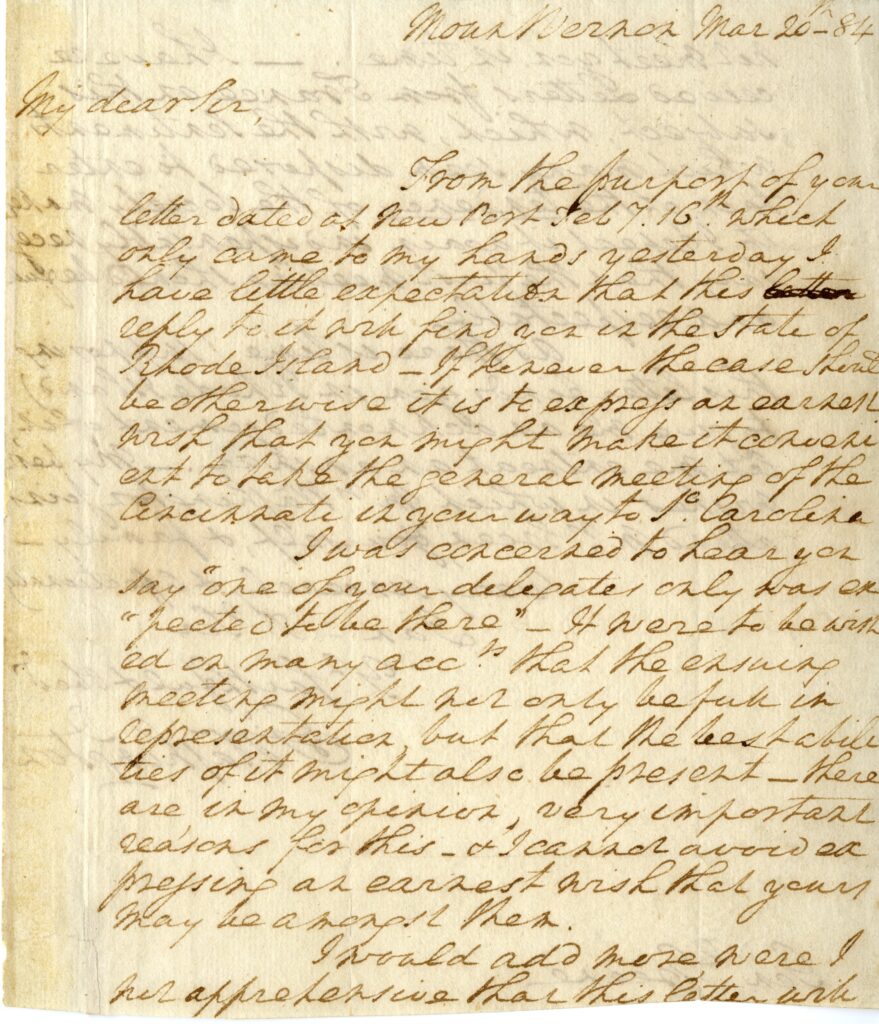
Mount Vernon, Va., March 20, 1784
The Society of the Cincinnati, Library purchase, 1975
In this letter, Washington urged Greene, who was president of the Rhode Island Society, to attend the first general meeting so that the “best abilities” might be present to consider Washington’s proposals to amend the Institution. The recent birth of his daughter and his own health problems prevented Greene from traveling from Newport to attend the Philadelphia meeting. After much debate, the delegates at the 1784 meeting voted in favor of amendments to the Institution and ordered the text to be sent to the constituent societies for approval.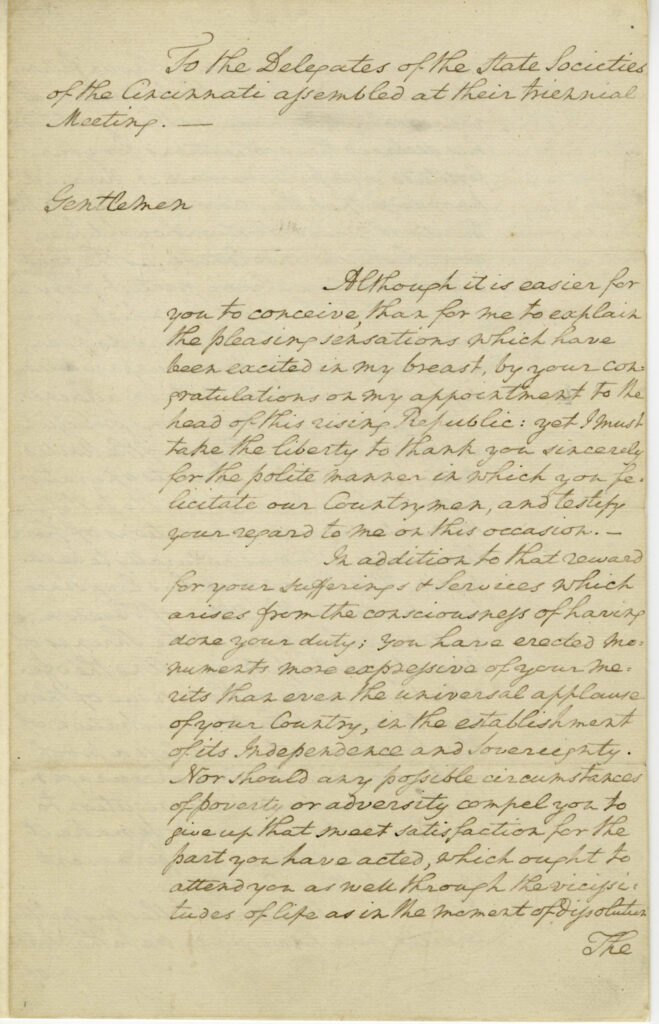
[Philadelphia, May 1790]
The Society of the Cincinnati Archives
The ratification of the United States Constitution and Washington’s election as president of the United States seem to have defused much of the public concern about the Society. Washington himself recognized this in his message sent to the delegates at the Triennial Meeting in May 1790: “The candor of your fellow-citizens acknowledges the patriotism of your conduct in peace, as their gratitude has declared their obligations for your fortitude and perseverance in war. A knowledge that they now do justice to the purity of your intentions ought to be your highest consolation, as the fact is demonstrative of your greatest glory.”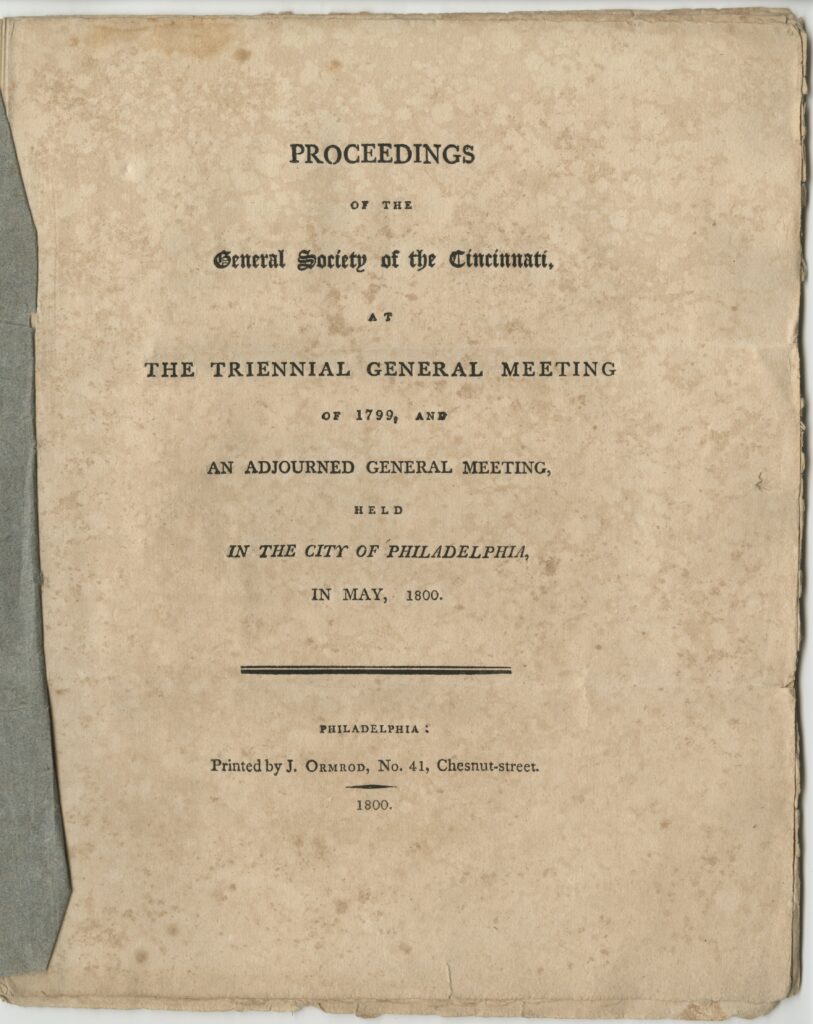
Philadelphia: Printed by J. Ormrod, 1800
The Society of the Cincinnati Archives
Although he never attended another Society meeting after 1784, George Washington was reelected president general at each of the Triennials through the 1790s. In May 1800, following Washington’s death the previous December, the General Society convened a special meeting to reconsider the status of the Institution. Concluding that the amended Institution had never been ratified by the states, the delegates resolved: “That the Institution of the Society of the Cincinnati, remains as it was originally proposed and adopted by the Officers of the American Army, at their Cantonments on the banks of the Hudson river, in 1783.”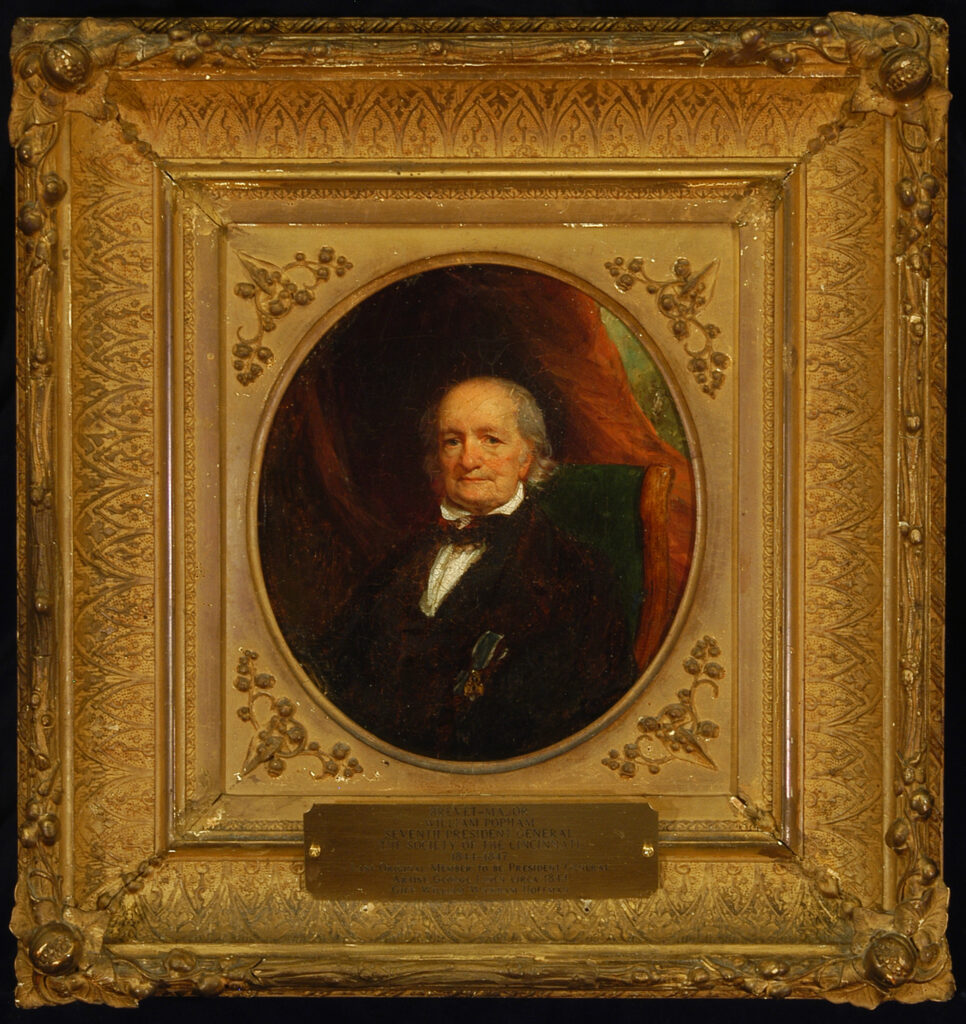
George Linen (1802-1888)
ca. 1844
The Society of the Cincinnati, Gift of William Wickham Hoffman, New York State Society of the Cincinnati, 1959
William Popham (1752-1847) was age ninety-two when he was elected the seventh president general of the Society—the last veteran of the Revolution to hold the office. Concerned that the younger members of the Society “are but slightly acquainted” with the history of the Society, he composed an address on the subject that was read before the Triennial Meeting of 1844. The Society of the Cincinnati was, he wrote, “the Alma Mater of the great and most resplendent empire that the world has ever seen.” In this oil portrait probably painted the year of his election, he wears badge of the office, the Diamond Eagle, that originally belonged to George Washington.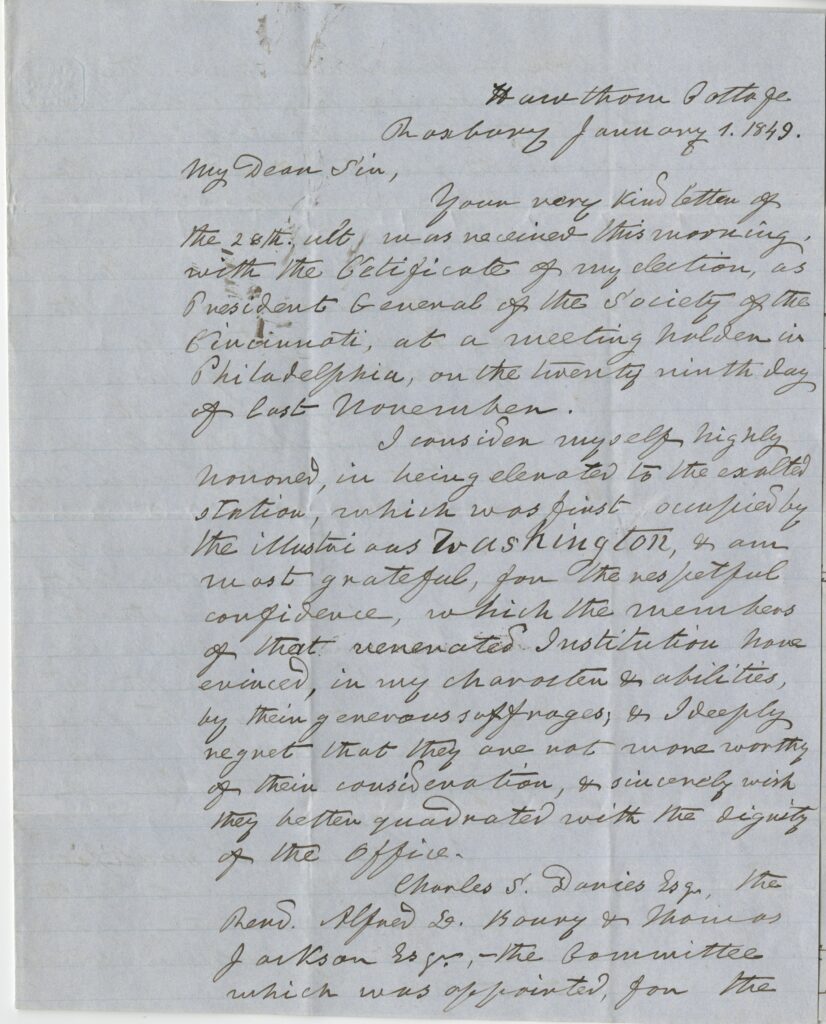
Hawthorn Cottage, Roxbury, Mass., January 1, 1849
The Society of the Cincinnati Archives
Henry Alexander Scammell Dearborn, the son of Gen. Henry Dearborn of New Hampshire, was the first hereditary member to be elected to the office of president general. Charles S. Daveis of Massachusetts was assigned the duty of delivering to him the Diamond Eagle. Noting that the presentation had taken place on December 14, 1848, the anniversary of George Washington’s death, Dearborn wrote to formally accept the office: “I consider myself highly honored in being elevated to the exalted station, which was first occupied by the illustrious WASHINGTON, & am most grateful for the respectful confidence which the members of that venerated Institution have evinced in my character & abilities.”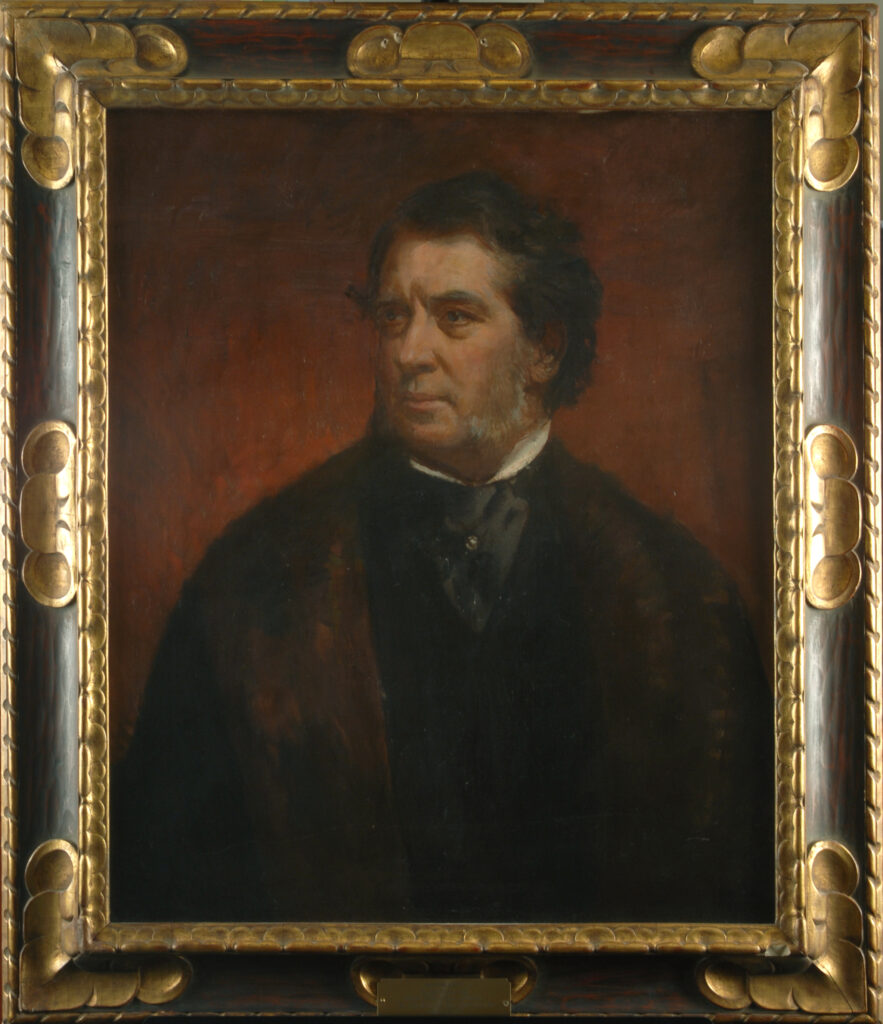
Unknown American artist
Mid-late 19th century
Collection of Hamilton Fish III, New York State Society of the Cincinnati
Elected the ninth president general of the Society in 1854, Hamilton Fish (1808-1893) would become its longest-serving leader, holding the office for thirty-nine years until his death in 1893. During his tenure he oversaw an expansion of the rules of eligibility to membership, fostered cordial relations among the state branches through the Civil War, and promoted the revival of constituent branches of the Society that had gone dormant.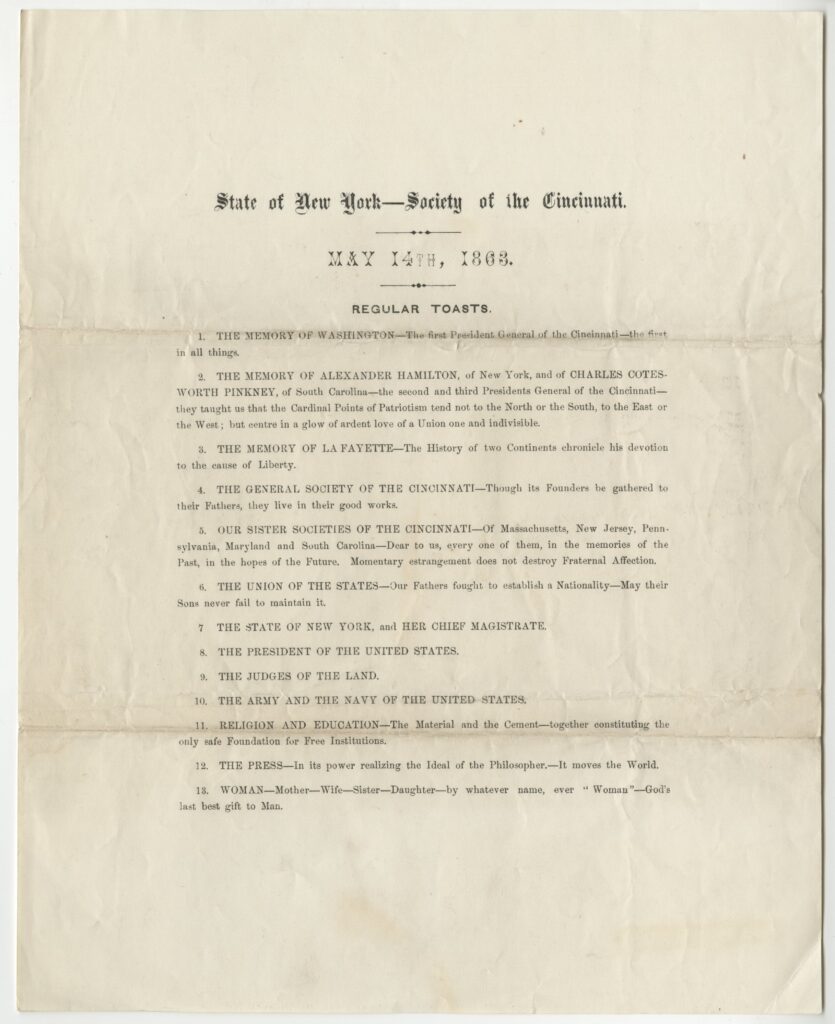
May 14, 1863
The Society of the Cincinnati Archives
During the Civil War, the General Society met for its appointed Triennial Meeting in New York in 1863, but no southern state was represented. The minutes of this meeting are silent on any political discussion, but at a dinner for the delegates hosted by the New York State Society, a toast was offered to “Our sister societies of the Cincinnati… Dear to us, every one of them, in the memories of the Past, in the Hope of the Future. Momentary estrangement does not destroy Fraternal Affection.”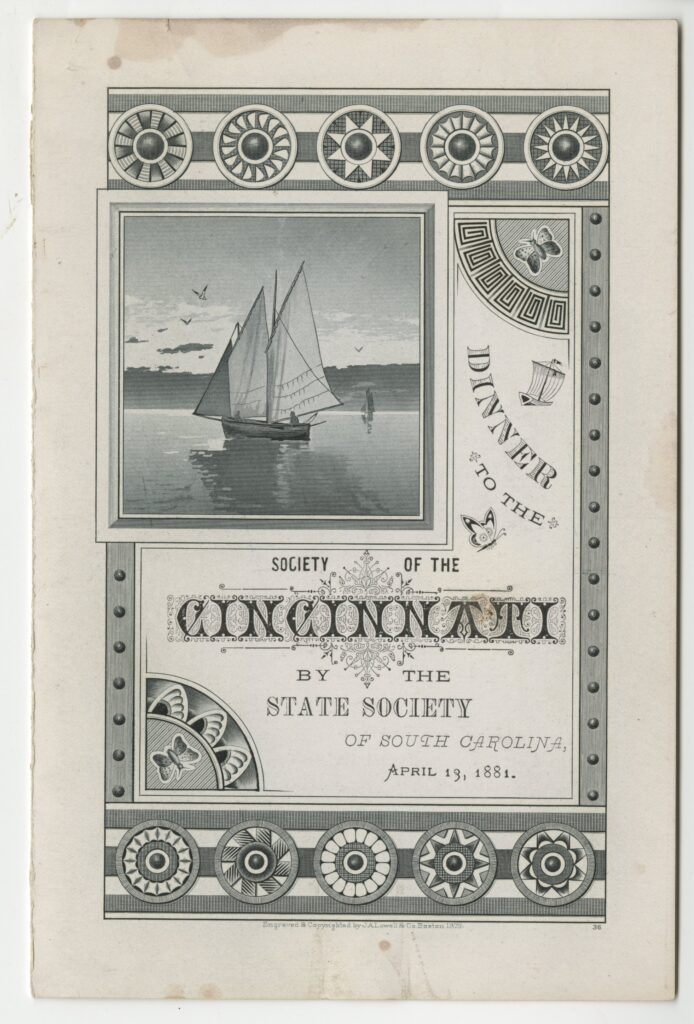
April 13, 1881
The Society of the Cincinnati Archives
The northern and southern state societies reunited quickly following the end of the Civil War. The South Carolina delegation was back in attendance by the 1869 Triennial Meeting, and in 1872 South Carolina Society member James Simons was elected vice president general. At his invitation, the Society held its 1881 Triennial Meeting in Charleston, South Carolina. At the Triennial banquet, the delegates raised their glasses to the host city, where “the traditions of the Revolution are the most cherished jewels of her inheritance.”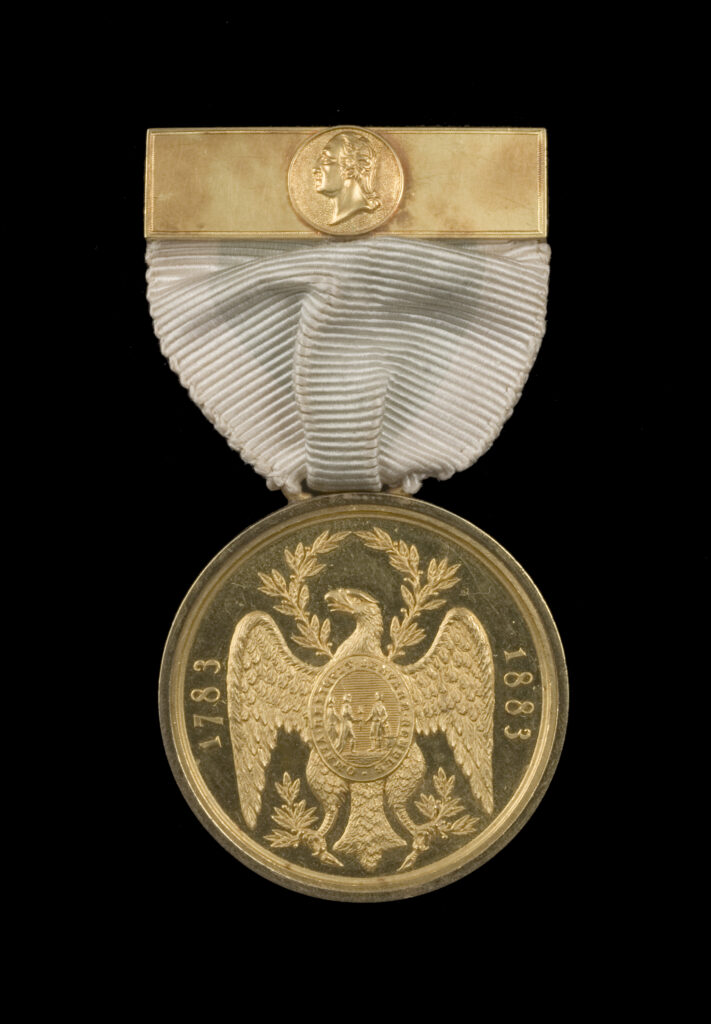
ca. 1883
The Society of the Cincinnati, Gift of Mrs. Robert A. Tilney in memory of Robert Tilney, 1959
Looking ahead to the Society’s centennial anniversary in 1883, the delegates at the Charleston Triennial authorized the creation of a commemorative medal, to be sold by subscription through the state societies. Francis Winthrop Palfrey of the Massachusetts Society oversaw the production of the centennial medal, which could be ordered in gold (like this example), silver, or bronze. The medal bears the Society Eagle with the dates 1783-1883 on its obverse; and its reverse is designed with a border of laurel and oak leaves surrounding a blank space in which the name of a member and his propositus could be engraved.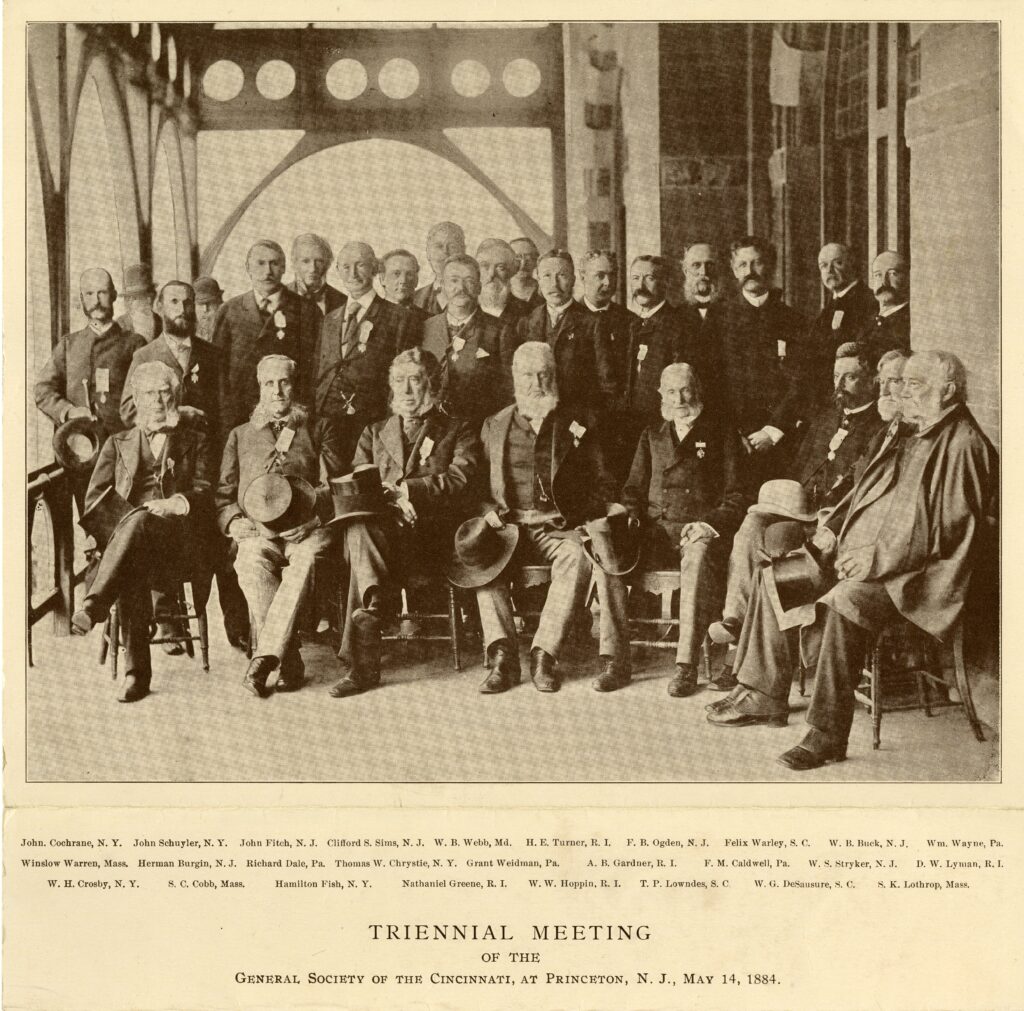
1884
The Society of the Cincinnati Archives
President General Hamilton Fish sits third from the left in this earliest-known group photograph taken at a Society Triennial Meeting. A full delegation of members of the Rhode Island Society, the first of the dormant societies to be reinstated, attended the Princeton Triennial of 1884. Not only was their invitation to host the 1887 Triennial Meeting in Newport accepted; one of their most ardent and active members, Asa Bird Gardiner, was elected secretary general.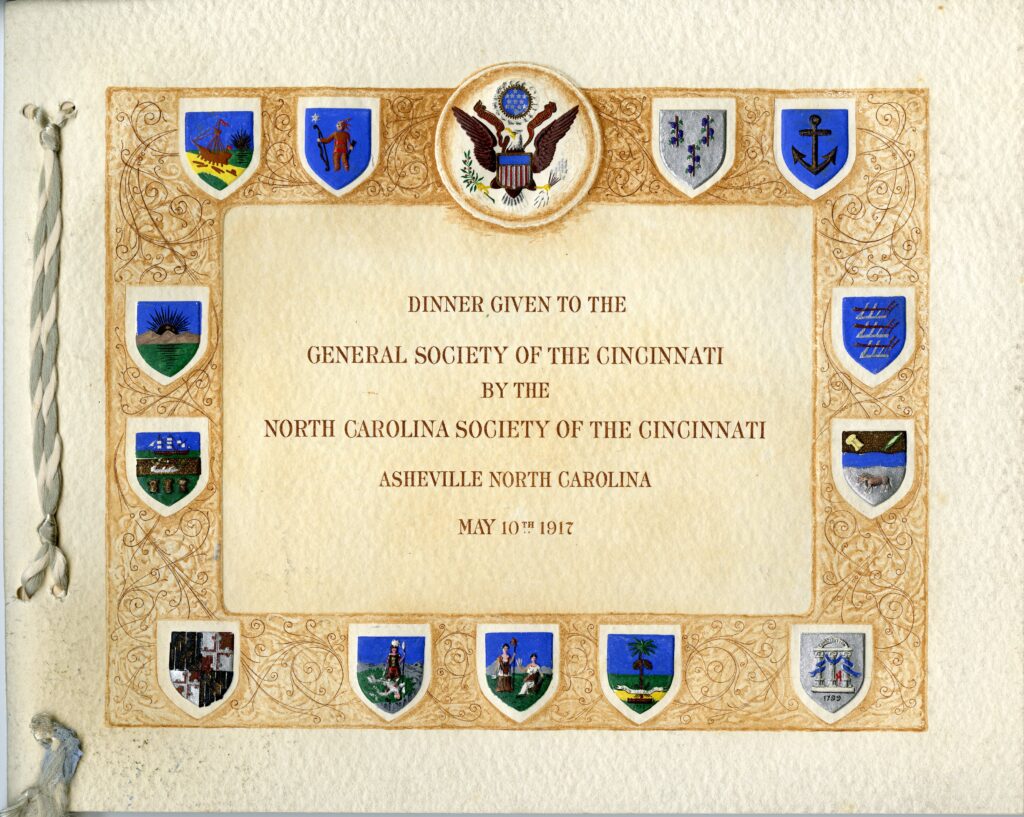
1917
The Society of the Cincinnati Archives
During the early twentieth century, the host societies produced elaborate souvenir programs and menus for the Triennial delegates. The Asheville Triennial of 1917 was the first general meeting hosted by the members of the North Carolina Society, who received great praise for their southern hospitality. The United States had just entered World War I when the Society met in Asheville. Although the Society had rarely spoken out on world events in the past, the delegates adopted a resolution in support of the war effort: “Remembering that it was the aid of France that made the United States a nation, we welcome the opportunity to repay the debt which was then incurred and to help a people whom we love and admire.”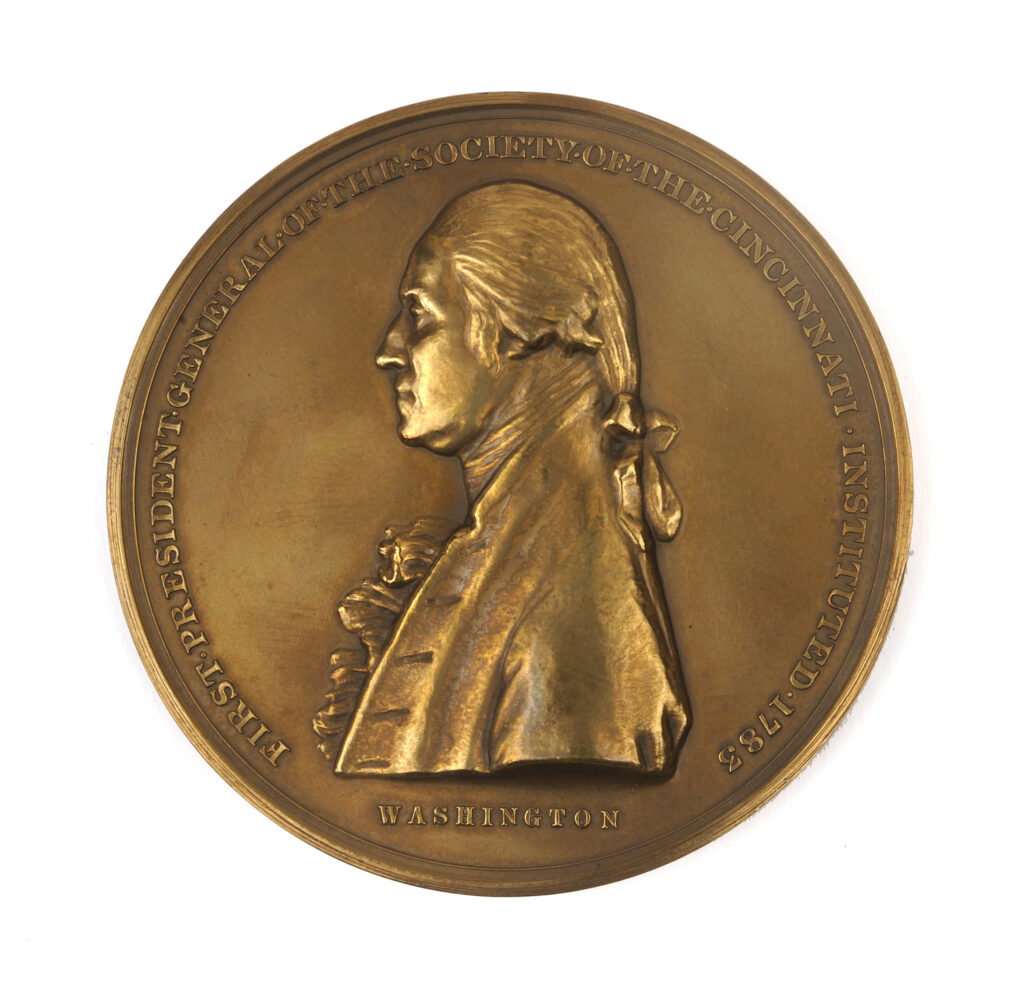
U.S. Mint, Philadelphia, after designs by George T. Morgan (1845-1925)
ca. 1923
The Society of the Cincinnati Collections
The Delaware State Society of the Cincinnati hosted the Triennial Meeting of 1923 in Wilmington and presented to the officers and delegates in attendance this commemorative bronze medal designed by George T. Morgan, chief engraver of the U.S. Mint at Philadelphia. The legend around the profile bust of Washington reads: “Washington. First President General of the Society of the Cincinnati. Instituted 1783.”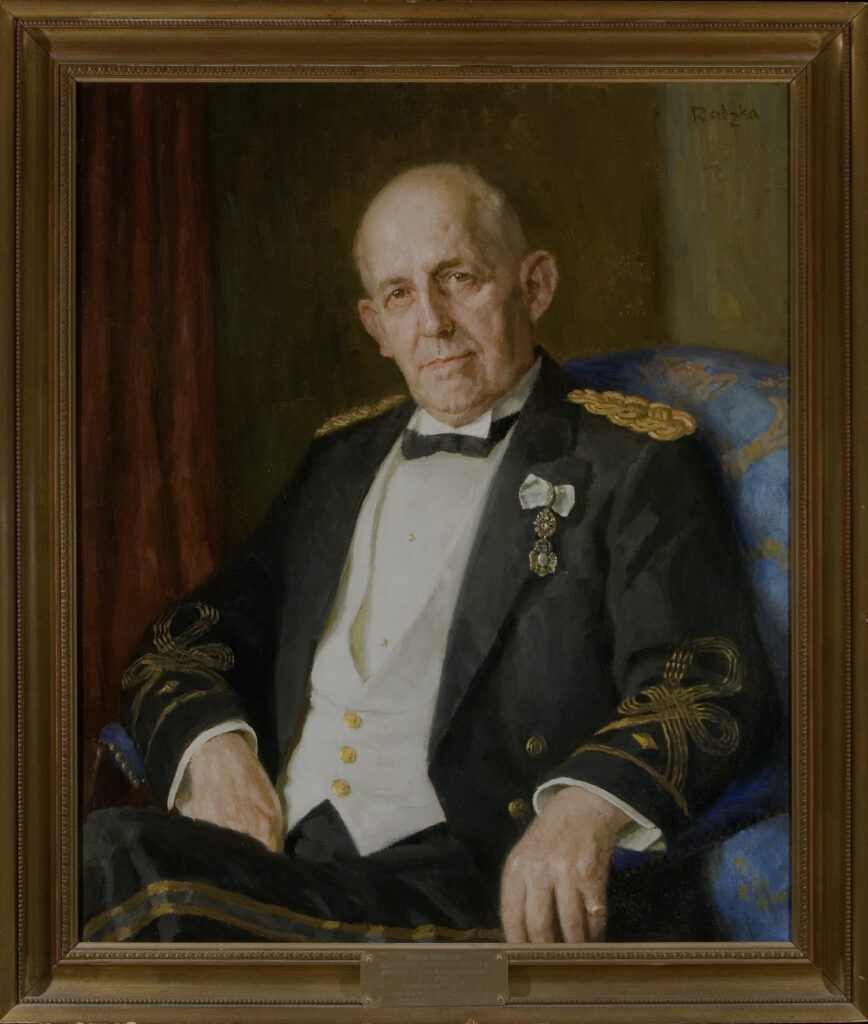
Arthur Ratzka (b. 1869)
ca. 1939-1941
The Society of the Cincinnati, Gift of the Society of the Cincinnati in the State of Connecticut, 1941
Elected thirteenth president general of the Society in 1939, Bryce Metcalf (1874-1951) led the Society through the years of World War II. He was the Society’s leading authority on membership, having published a master list of original members and eligible lines that is still in use today. His scholarly contributions, coupled with the Society’s acquisition in 1938 of Anderson House as its first national headquarters, ushered in a new era of growth and activity for the Society. He wears the Diamond Eagle in this oil portrait painted during the first years of his term.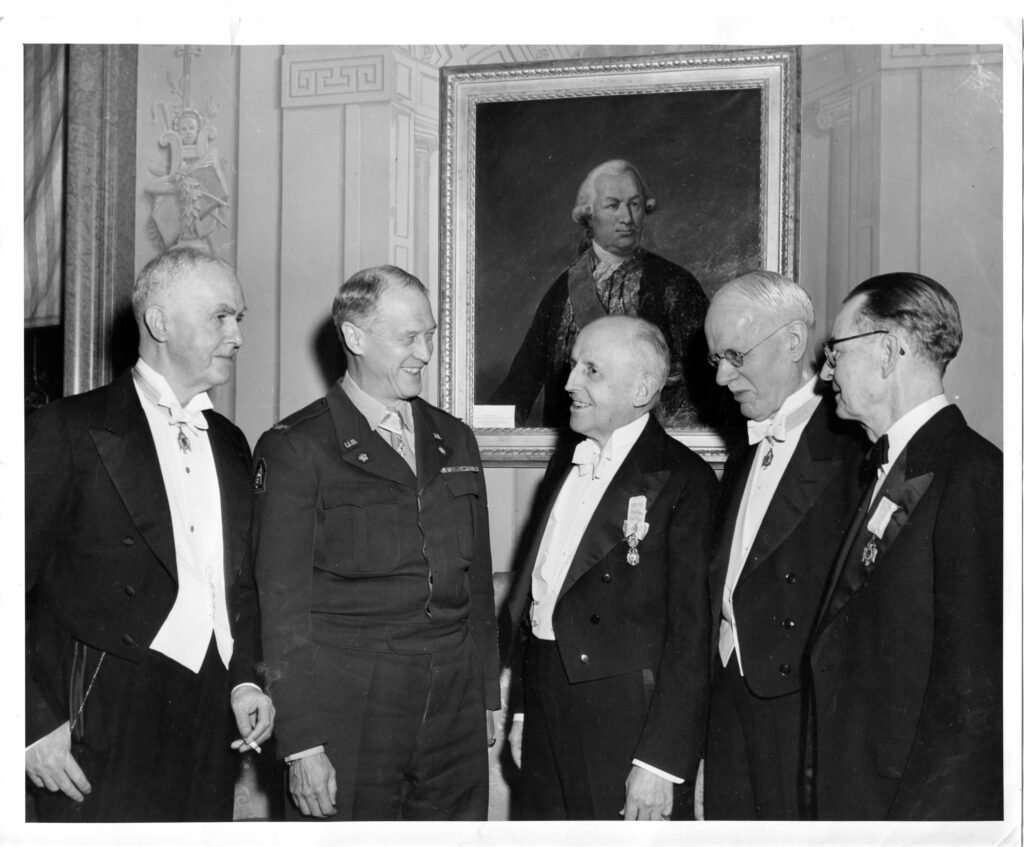
1947
The Society of the Cincinnati Archives
This photograph of the general officers in the Great Stair Hall of Anderson House in 1947 is inscribed on the back: “The first triennial meeting under our own roof.” Pictured from left to right are William Marbury Beall, assistant treasurer general; Edgar Erskine Hume, vice president general; Bryce Metcalf, president general (wearing the Diamond Eagle); Horace Morison, treasurer general; and Lawrence Monck Pinckney, assistant treasurer general.